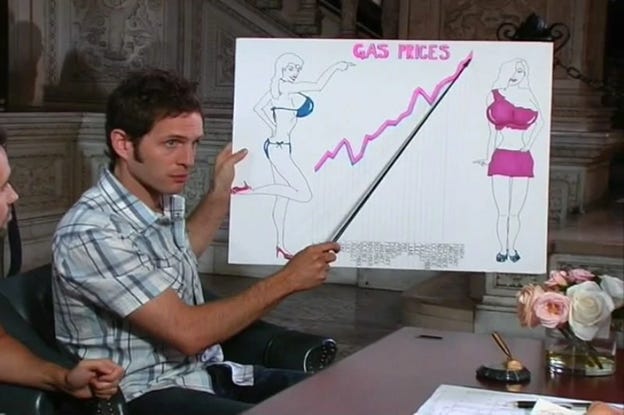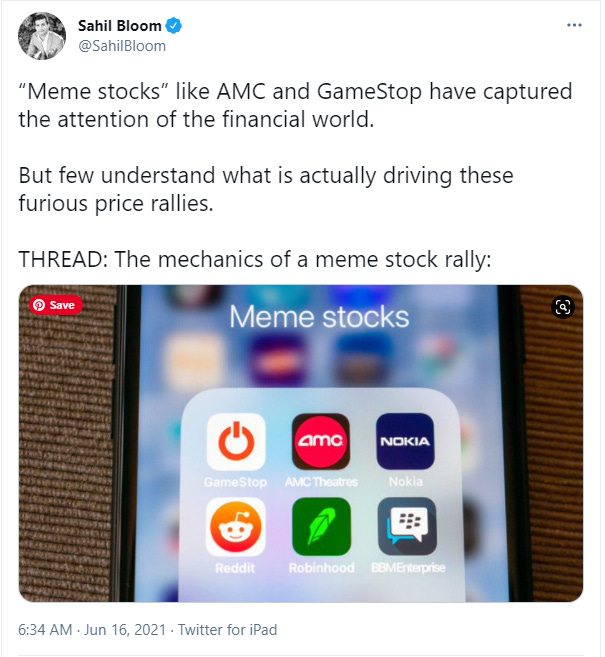Last week we covered Meme Stocks, so today it’s Econ 101.
Sorry friends, but inflation has once again dominated the financial news cycle, as the Federal Reserve (‘The Fed’) ended their most recent meeting yesterday. They warned that inflation may be here to stay, so we thought now might be a good time to dive in. So what is inflation exactly? And why does it matter so much?
Inflation is the rise in the general price of goods and services. It’s measured using something called the Consumer Price Index (CPI), which attempts to measure the overall cost of living using eight main categories covering over 200 items, including groceries, housing, and apparel. It’s basically an average of all the stuff you pay for every month.
And, let’s face it, the lockdowns are over which means you need clothes now.
What’s really important is: Does it cost more to live and buy things this year than it did last year?
Now, most of you are probably screaming YES! Look at gas prices, you idiot.
In this case, you would be correct and given how drastically different things are from last year when we were in a lockdown. You could do a mad lib yelling at us about how much more things cost.
Of course things cost more look at _________ you _________!
But as we mentioned before, CPI is average and includes many goods and services from a lot of places. Let’s look at a chart:
This chart breaks out components of inflation (CPI), showing that you, a very stable genius, were correct. Healthcare and college costs are through the roof. But, many other things, namely technology, have become a lot cheaper over the past 20 years. And while overall things cost more, wages rose at a faster pace meaning the average person is better off now than 20 years ago. So the system works!
The “mysterious” Fed mentioned earlier is in charge of managing inflation. Their stated goal is to keep it around 2% (Meaning $1000 today = $980 next year). And our proxy for inflation, CPI, has averaged 1.73% over the last ten years. So good work, Fed!
At this point, you may be wondering why is the Fed actively trying to make stuff cost more? Inflation was 5% over the last 12 months. This means the $1,000 stimulus you had saved under the mattress last year can now only buy $950 worth of Mimosas! How are you supposed to have a hot girl/guy summer on that budget?
Inflation means your money is worth a little less every year. This seems dumb. So, why do we not only permit inflation to occur but actively encourage it?
You could write a dissertation answering that question, which we’re not going to do because we’d like you to read the rest of this article. The TL;DR version: inflation encourages everyone to spend money now, which, in turn, keeps the economy growing.
If your money will be worth less next year, why wait to buy that new car or house now? Scale this up for businesses of all sizes: time to open that new store, buy that extra delivery truck, and double down on inventory to keep the economy growing.
So what do you do? Many of you have saved money in cash, only to read this blog and find out the Fed is inflating away your cash a little bit every year. Not cool, Fed.
What’s the Upside? You’ve got a few options...
Take all your cash and bet it on AMC or whatever stock is blowing up at the moment? Please don’t do that.
No, despite earning scant interest, cash still has a role to play. Cash can keep you from running up a balance on your credit cards or bail you out in a pinch. It’s about striking a balance between maintaining enough cash to meet unexpected costs and making sure you have something that can outpace inflation as it nips away at your purchasing power.
Look at things like stocks, bonds, real estate, or other financial instruments to potentially help outpace inflation.
We’re closely watching the inflation trend because it has the potential to generate significant opportunities for those who are prepared. Share this post and subscribe today to stay up to date.
Explain it to me like a small child.
Or better yet, a golden retriever.
As a follow-up from last week’s post about meme stocks, we wrote a quick thread to explain short-selling. Prepare to return to high school.
We also highly recommend Sahil Bloom. He’s a kindred spirit to the Weekly Upside who tweets @sahilbloom.
For Your Weekend:
This is where we’ll post a round-up of essays, podcasts, and streaming shows to check out over your weekend. We cast a wide net so you don’t have to.
Read:
“How America Fractured Into Four Parts" by George Packer (The Atlantic)
This thought-provoking article articulates the cultural and political shift we’ve witnessed over the last few years. Keep an open mind and give it a read. Here’s an excerpt:
Through much of the 20th century, the two political parties had clear identities and told distinct stories. The Republicans spoke for those who wanted to get ahead, and the Democrats spoke for those who wanted a fair shake. Republicans emphasized individual enterprise, and Democrats emphasized social solidarity, eventually including Black people and abandoning the party’s commitment to Jim Crow. But, unlike today, the two parties were arguing over the same recognizable country. This arrangement held until the late ’60s—still within living memory.”
“Technology Saves the World” by Marc Andreessen (a16z)
Where did the modern office environment come from? If we started over, would we organize work the same way? Marc Andreessen weighs in:
“What we have learned — what we were forced to learn — during the COVID lockdowns has permanently shattered these assumptions. It turns out many of the best jobs really can be performed from anywhere, through screens and the internet. It turns out people really can live in a smaller city or a small town or in rural nowhere and still be just as productive as if they lived in a tiny one-room walk-up in a big city. It turns out companies really are capable of organizing and sustaining remote work even — perhaps especially — in the most sophisticated and complex fields.”
“Why 12 Worked: Inside Two Years of Secrecy and the Making of a New Playoff Model” by Ross Dellenger (Sports Illustrated)
After a decade of ignoring what they should have done from the start, the traditionally glacial NCAA has embraced a real college football playoff. Read how it came together:
“Before that March 2020 meeting, the four men and two others—Hancock and Dave Marmion, the CFP chief financial officer—met at least a half-dozen times, usually in small hotel conference rooms, equipped with two easels of paper, masking tape and markers. By the end of the meeting, the walls would be completely covered in models similar to those that had social media buzzing last week.”
Listen:
Slow Burn - Season 5: The Road to the Iraq War
The United States invaded Iraq in 2003. At the time, most Americans supported the move. Now, it’s considered a disaster. What happened?
Slow Burn is an outstanding podcast series from Slate Magazine that, like Serial (remember Serial?) tackles one topic per season. Each episode is about an hour long. New episodes release weekly.
Watch:
Bo Burnham: Inside (Netflix)
The latest comedy special from Bo Burnham should come with a warning label: straightforward, set-up punchline comedy this ain’t. It’s also a contender for the most creative piece of genuine art to come from the nationwide lockdowns. Not sure if this is right for you? Watch Bo perform ‘Welcome to the Internet.’ If you’re intrigued, it’s the special for you. If you’re confused, maybe look elsewhere.
Edge of Tomorrow (Netflix)
Are you tired of superhero franchises? Throw this one on. Earth is attacked by aliens in the near future (not original). Tom Cruise plays a PR man for the US military who is assigned to a suicide mission (Jerry Maguire meets Halo?), wherein he promptly dies (go on…). He’s then forced to relive the same day over and over until he figures it out (Dark Souls fans are nodding along). Sure, it came out in 2014, but it’s entirely original and a fun popcorn flick for a summer night.
Follow:
Twitter: @sahilbloom.
Makes his bones with Twitter threads focused on demystifying financial concepts. A kindred spirit.










With inflation on an upswing and tax rates at historic lows. What are your thoughts on tax deferred vs taxable retirement contributions for young (<35) people?